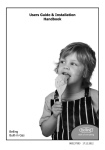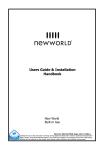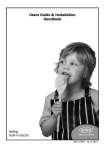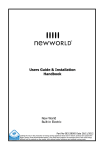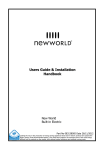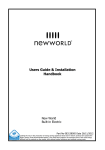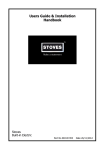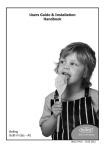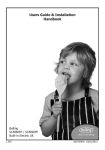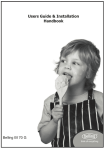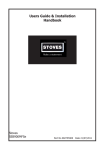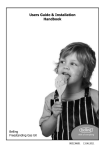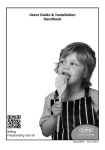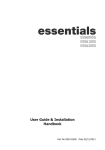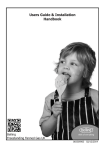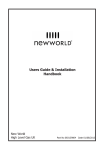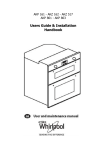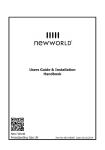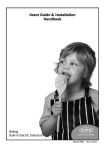Download Stoves SGB600PS
Transcript
Users Guide & Installation Handbook Stoves Built-in Gas Part No 083137102 Date 26/11/2012 contents & INTRODUCTION CONTENTS • SAFETY • USING THE product • cleaning • INSTALLATION INSTRUCTIONS • technical data • CUSTOMER CARE INTRODUCTION Thank you for buying this Britishbuilt appliance from us. This guide book is designed to help you through each step of owning your new cooker, from installation to use. Please read it carefully before you start using your product, as we have endeavored to answer as many questions as possible, and provide you with as much support as we can. If, however, you should find something missing, or not covered, please contact our Customer Care team. Their number is located on the back page of this book. For customers outside the UK and Northern Ireland, please contact your local supplier. When you dial this number you will hear a recorded message and be given a number of options. This indicates that your call has been accepted and is being held in a queue. Calls are answered in strict rotation as our Customer Care representatives become available. Alternatively, general information, spares and service information is available from our website. The address is located on the back page of this book. Warranty Your new appliance comes with our 12-month guarantee, protecting you against electrical and mechanical breakdown. To register your appliance please call 0844 481 0182, complete the registration form included or register online at the web address located on the back page of this book. For full terms & conditions of the manufacturer’s guarantee, refer to the website on the back of this book. In addition, you may wish to purchase an extended warranty. A leaflet explaining how to do this is included with your appliance. Our policy is one of constant development and improvement, therefore we cannot guarantee the strict accuracy of all of our illustrations and specifications - changes may have been made subsequent to publishing. Gas warning If you smell gas: Do not try to light any appliance. Do not touch any electrical switch. Call the Gas Emergency Helpline at TRANSCO on: 0800 111999 Safety Before Using the product Make sure that you have removed all packaging and wrapping. Some of the items inside this appliance may have additional wrapping. General WARNING! - The appliance and its accessible parts become hot during use. Care should be taken to avoid touching heating elements. Children less than 8 years of age shall be kept away unless continously supervised. This appliance can be used by children aged from 8 years and above and persons with reduced physical sensory or mental capabilities or lack of experience and knowledge if they have been given supervision or instruction concerning the use of the appliance in a safe way and understand the hazards involved. Children shall not play with the appliance. Cleaning and user maintenance shall not be made by children without supervision. WARNING! Unattended cooking on a hob with fat or oil can be dangerous and may result in fire. NEVER try to extinguish a fire with water, but switch off the appliance and then cover the flame with a lid or damp cloth. WARNING! - Danger of fire: Do not store items on the cooking surfaces. WARNING! - Servicing should be carried out only by authorised personnel. • The appliance must never be disconnected from the mains supply during use, as this will seriously affect the safety 5.1 Safety and performance, particularly in relation to surface temperatures becoming hot and gas operated parts not working efficiently. The cooling fan (if fitted) is designed to run on after the control knob has been switched off. • Do not spray aerosols in the vicinity of this appliance while it is in operation. • Do not store or use flammable liquids or items in the vicinity of this appliance. • Do not modify this appliance. CAUTION: The use of a gas cooking appliance results in the production of heat, moisture and products of combustion in the room in which it is installed. Ensure that the kitchen is well ventilated especially when the appliance is in use: keep natural ventilation holes open or install a mechanical ventilation device (mechanical extractor hood). Prolonged intensive use of the appliance may call for additional ventilation, for example opening of a window, or more effective ventilation, for example increasing the level of mechanical ventilation where present. WARNING! Do not operate the appliance without the glass panel correctly fitted. WARNING! Never put items directly on the base of the oven 5.1 Safety or cover the oven base with foil, as this can cause the base element to overheat. WARNING! The top element gets extremely hot when in use, so take extra care to avoid touching it. WARNING! Do not modify the outer panels of this appliance in any way. WARNING! This appliance must be earthed. WARNING! There is a risk of electric shock, so always make sure you have turned off and unplugged your appliance before starting. Always allow the product to cool down before you change a bulb. WARNING! - Do not use harsh abraisive cleaners or sharp metal scrapers to clean the ovendoor glass since they can scratch the surface, which may well result in shattering of the glass. WARNING! Do not operate the appliance without the the glass panel correctly fitted. CAUTION: This appliance is for cooking purposes only. It must not be used for other purposes, for example room heating. Oven / Grill Do • Always take care when removing food from the oven as the area around the cavity may be hot. • • Always use oven gloves when handling any utensils that have been in the oven as they will be hot. Always make sure that the oven shelves are resting in the correct position between two runners. Do not place the oven shelves on top of the highest runner, as this is not 5.1 Safety stable and can lead to spillage or injury. • Always use the Minute Minder (if fitted) if you are leaving the oven unattended - this reduces the risk of food burning. Do Not • Never place items on the door while it is open. • Never wrap foil around the oven shelves or allow foil to block the flue. • Never drape tea towels near the oven while it is on; this will cause a fire hazard. • Never pull heavy items, such as turkeys or large joints of meat, out from the oven on the shelf, as they may overbalance and fall. Never use this appliance to heat anything other than food items and do not use it for heating the room. 5.1 USING THE GRILL - ELECTRIC (if fitted) Caution: Accessible parts may be hot when the grill is used - young children should be kept away. a grill pan handle can be purchased as an optional extra from our spares department quoting the numbers below. Handle - 082283705 Handle grip - 082469100 Complete grillpan pack - 012635666 Contact details can be found on the customer care page. If cleaning the grill pan when it is hot, use oven gloves to move it. Food for grilling should be positioned centrally on the trivet. Using the grill With the grill trivet removed the food is placed directly on the base of the grill pan - eg: when cooking whole fish or browning dishes such as cauliflower cheese. To switch off, turn the control knob to the off position. Aluminium foil Using aluminium foil to cover the grill pan, or putting items wrapped in foil under the grill creates a fire hazard. The cooling fan (if fitted) When the grill is switched on, after a short delay, the cooling fan comes on to keep the fascia and control knobs cool during grilling. The fan may continue to operate for a period after the grill has been switched off. During use the fan may cycle on and off, this is normal. Important: The grill door must be fully open when the grill is used. Open the grill door. Turn the grill control knob to the grill symbol position. For best cooking results, we recommend that you preheat the grill for about 3 minutes. Push the grill pan towards the back of the shelf, to position it under the grill. The speed of grilling can be controlled by selecting a higher or lower shelf position. For toasting, and for grilling foods such as bacon, sausages or steaks, use a higher shelf position. For thicker foods such as chops or chicken joint pieces, use a middle to low shelf position. The grill trivet, inside the grill pan, can be inverted to give a high or low position, or it may be removed. The HIGH trivet position is suitable for toasting bread. The LOW trivet position is suitable for grilling all types of meat & fish. 7.130 using the top oven - gas Using the top oven Preheating Ignition Always preheat the top oven for 15 minutes. However, if the main oven is being used at the same time, then preheating may not be necessary. The cooking time may need to be shortened slightly, or the cooking temperature adjusted, to allow for heat transfer from the main oven to the top oven if both ovens are used together. Push in and turn the top oven control knob to the ‘FULL ON’ position. Hold the control knob in, and press the ignition switch (if fitted) or hold a lighted match or taper to the burner, until the burner lights. Hold the control knob in for 15 seconds. Do not hold the control knob in for longer that 15 seconds. If the burner fails to light within this time, release the control knob and wait one minute before attempting further ignition. Turn the control knob to the required setting. To switch off, return the control knob to the off position. Note; Some appliance’s are automatic ignition and do not have an ignition switch. Using the top oven The top oven can be used in the same way as the main oven, to cook the full range of dishes, but it is a SECONDARY oven and there are some differences. Foods cooked in the top oven should be in relation to the oven size. Larger dishes, or food which may rise during cooking, should be cooked in the main oven. Large items, wide tins and tall items such as rich fruit cakes should be cooked in the main oven to obtain optimum results. Notes: As part of the cooking process, hot air is expelled through a vent at the top of the oven(s). When opening the oven door, care should be taken to avoid any possible contact with potentially hot air, since this may cause discomfort to people with sensitive skin. We recommend that you hold the underneath of the oven door handle. If you are not preheating the oven, the cooking times in the baking guide may need to be extended, as they are based on a preheated oven. The oven must be preheated when reheating frozen or chilled foods, and we recommend preheating for yeast mixtures, batters, soufflés and whisked sponges. Put the oven shelves in the position required before preheating the oven. Zones of heat The temperature at the centre of the oven corresponds with the selected gas mark and is slightly higher towards the top of the oven and slightly lower towards the oven base. These zones of heat can be useful as different dishes requiring different temperatures can be cooked at the same time, when more than one shelf is used. The temperature at the oven base is suitable for cooking baked vegetables, baked fruit, milk pudding etc, and for warming bread rolls, soup, coffee, or ovenproof plates and dishes. If you find that over a period of time, the oven becomes hotter when used at a particular gas mark, the thermostat may need to be replaced. using the top oven - gas Oven furniture SLOW COOKING Baking tray and roasting tins For best cooked results and even browning, the maximum size baking trays and roasting tins that should be used are as follows; Baking tray 350mm x 330mm Roasting tin 370mm x 320mm Position baking trays and roasting tins on the middle of the shelves, and leave one clear shelf position between shelves, to allow for circulation of heat. Oven shelves Extra shelves may be ordered from your local supplier. The oven shelf must be positioned with the upstand at the rear of the oven and facing upwards. The top oven shelf helps to ensure even baking in the top oven. It has a rear deflector fitted to it, and is not intended for use in the main oven. Oven light (if fitted) Press the light button on the facia panel. If there is no light button the oven light will come on when the oven control is operated. Make sure that frozen foods are thoroughly thawed before cooking. Do not slow cook joints of meat or poultry weighing more than 2¼kg / 4½lb. Always use the top half of the oven for slow cooking. For roasting joints of meat or poultry, and for pot roasts preheat the oven to gas mark 6 and cook for 30 minutes, then adjust the oven control to the “S” slow setting for the remainder of the cooking time. Slow cooking times will be about three times as long as conventional cooking times. using the top oven - gas Top oven baking guide Dish Recommended Suggested Approximate gas mark shelf cooking time position (preheated oven) Scones 7 top - middle 10 - 15 mins Meringues “S” slow setting bottom 2 - 3 hours Small cakes 5 middle 15 - 25 mins Whisked sponge 5 middle 20 - 30 mins Swiss roll 6 middle 10 - 12 mins Victoria sandwich 4 middle 20 - 35 mins Cakes (2 x 180mm / 7” per shelf) Genoese Sponge (side by side) 5 middle 25 - 30 mins Rough Puff 7 middle cooking time Flaky / Puff 6 middle depends on Shortcrust 6 middle recipe & type Flan 6 middle of filling Shortbread fingers 5 middle - top Nut brownies 5 middle Brandy snaps 4 middle - top Flapjacks 4 middle - top Ginger nuts 5 middle - top (2 x 180mm / 7” per shelf) Pastry Biscuits Baking guide hints The gas mark settings and times given in the top baking guides are based on dishes made wit block margarine. If tub margarine is used, it may be necessary to reduce the gas mark setting. If a different gas mark setting to that shown in our guide is given in a recipe, the recipe instruction should be followed. The cooking times given in the baking guides are based on a preheated oven. If you do not preheat the oven, cooking times should be extended. using the top oven - gas Traditional fruit cakes Roast turkey It should be remembered that ovens can vary over time, therefore cooking times can vary, making it difficult to be precise when baking fruit cakes. Roasting turkey involves cooking two different types of meat - the delicate light breast meat, which must not be allowed to dry out, and the darker leg meat, which takes longer to cook. It is necessary therefore, to test the cake before removal from the oven. Use a fine warmed skewer inserted into the centre of the cake. If the skewer comes out clean, then the cake is cooked. • Do not attempt to make Christmas cakes larger than the oven can cope with, you should allow at least 25mm (1 inch) space between the oven walls and the tin. • Always follow the temperatures recommended in the recipe. • To protect a very rich fruit cake during cooking, tie 2 layers of brown paper around the tin. • We recommend that the cake tin is not stood on layers of brown paper, as this can hinder effective circulation of air. • Do not use soft tub margarine for rich fruit cakes, unless specified in the recipe. • Always use the correct size and shape of tin for the recipe quantities. The turkey must be roasted long enough for the legs to cook, so frequent basting is necessary. The breast meat can be covered once browned. • Always make sure that the turkey is completely thawed and that the giblets are removed before cooking. • Turkey should be roasted at gas mark 5 for 20 minutes per lb, plus 20 minutes, unless packaging advises otherwise. • The turkey can be open roasted, breast side down, for half of the cook time, and then turned over for the remainder of the cooking time. • If the turkey is stuffed, add 5 minutes per lb to the cooking time. • If roasting turkey covered with foil, add 5 minutes per 1lb to the cooking time. To test if the turkey is cooked, push a fine skewer into the thickest part of the thigh. If the juices run clear, the turkey is cooked. If the juices are still pink, the turkey will need longer cooking. Please note:- for all other Roasting guides refer to main oven section and see table. using the top oven - gas Roasting guide Notes: The times given in the roasting guide are only approximate, because the size and age of the bird will influence cooking times as will the shape of a joint and the proportion of the bone. • When cooking stuffed meat or poultry calculate the cooking time from the total weight of the meat plus the stuffing. • For joints cooked in foil or covered roasters, and for lidded casseroles, add 5 minutes per 450g (1lb) to the calculated cooking time. • Smaller joints weighing less than 1.25kg (2½lb) may require 5 minutes per 450g (1lb) extra cooking time. • Position the oven shelf so that the meat or poultry is in the centre of the oven. • It is recommended that the appliance is cleaned after open roasting. Frozen meat should be thoroughly thawed before cooking. For large joints it is advisable to thaw overnight. Frozen poultry should be thoroughly thawed before cooking. The time required depends on the size of the bird - eg; a large turkey may take up to 48 hours to thaw. Use of a trivet with a roasting tin will reduce fat splashing and will help to keep the oven interior clean. Alternatively, to help reduce fat splashing, potatoes or other vegetables can be roasted around the meat/poultry. Cook in oven at Gas Mark 5 Approximate Cooking Time (preheated oven) Beef Lamb Rare 20 minutes per 450g (1lb), plus 20 minutes Medium 25 minutes per 450g (1lb), plus 25 minutes Well done 30 minutes per 450g (1lb), plus 30 minutes Medium 25 minutes per 450g (1lb), plus 25 minutes Well Done 30 minutes per 450g (1lb), plus 30 minutes Pork 35 minutes per 450g (1lb), plus 35 minutes Poultry 20 minutes per 450g (1lb), plus 20 minutes USING THE MAIN OVEN - GAS Using the main oven Ignition Push in and turn the main oven control knob to the ‘FULL ON’ position. Hold the control knob in, and press the ignition switch (if fitted) or hold a lighted match or taper to the burner, until the burner lights. If after 15 seconds, the burner has not lit, turn off the oven and leave the compartment door open. Wait at least one minute before a further attempt to ignite the burner. Do not hold the control knob in for more than 15 seconds. Turn the control knob to the required setting. Note; Some appliance’s are automatic ignition and do not include neither require an ignition switch. To turn off, return the control knob to the “off” position. Preheat the main oven for 15 minutes. If you are not preheating the oven, the cooking times in the baking guides may need to be extended, as they are based on a preheated oven. The oven must be preheated when reheating frozen or chilled foods, and we recommend preheating for yeast mixtures, batters, soufflés and whisked sponges. Put the oven shelves in the position required before preheating the oven. Zones of heat The temperature at the centre of the oven corresponds with the selected gas mark and is slightly higher towards the top of the oven and slightly lower towards the oven base. These zones of heat can be useful as different dishes requiring different temperatures can be cooked at the same time, when more than one shelf is used. The temperature at the oven base is suitable for cooking baked vegetables, baked fruit, milk pudding etc, and for warming bread rolls, soup, coffee, or ovenproof plates and dishes. If you find that over a period of time, the oven becomes hotter when used at a particular gas mark, the thermostat may need to be replaced. Oven light (if fitted) Press the light button on the facia panel. If there is no light button the oven light will come on when the oven control is operated. Oven furniture Baking tray and roasting tins For best cooked results and even browning, the maximum size baking trays and roasting tins that should be used are as follows; Baking tray 350mm x 330mm Roasting tin 370mm x 320mm Position baking trays and roasting tins on the middle of the shelves, and leave one clear shelf position between shelves, to allow for circulation of heat. Oven shelves Extra shelves may be ordered from your local supplier. The oven shelf must be positioned with the up-stand at the rear of the oven and facing upwards. Slow cooking Make sure that frozen foods are thoroughly thawed before cooking. Do not slow cook joints of meat or poultry weighing more than 2¼kg/4½lb. Always use the top half of the oven for slow cooking. USING THE MAIN OVEN - GAS For roasting joints of meat or poultry, and for pot roasts preheat the oven to gas mark 6 and cook for 30 minutes, then adjust the oven control to the “S” slow setting for the remainder of the cooking time. Slow cooking times will be about three times as long as conventional cooking times. Main oven baking guide Dish Scones Meringues Cakes Small cakes Whisked sponge Swiss roll Victoria sandwich (2 x 180mm/7”) Genoese sponge Madeira (180mm/7”) Gingerbread Semi rich fruit cake (205mm/8”) Christmas cake (205mm/8”) Dundee cake (205mm/8”) Pastry Rough Puff Flaky/Puff Shortcrust Flan Biscuits Nut brownies Brandy snaps Flapjacks Gingernuts Recommended gas mark Suggested shelf position Approximate cooking time 7 “S” slow set middle - top bottom 8 - 15 mins 2 - 3 hours 5 5 6 4 middle middle middle middle 15 20 10 20 4 3 3 2 or 3 middle middle middle middle - top 20 - 30 mins 1 - 1¼ hours 1 - 1¼ hours 2½ - 3 hours 1 or 2 bottom 3 middle - bottom depending on recipe 2 - 2½ hours 7 6 6 6 middle middle middle middle - top top top top Cooking time depends on recipe and type of filling 5 4 4 4 middle middle middle middle - top top top top 25 10 20 10 (preheated oven) - top top top top - - 25 25 12 30 35 12 25 20 mins mins mins mins mins mins mins mins USING THE MAIN OVEN - GAS Traditional fruit cakes Roast turkey It should be remembered that ovens can vary over time, therefore cooking times can vary, making it difficult to be precise when baking fruit cakes. Roasting turkey involves cooking two different types of meat - the delicate light breast meat, which must not be allowed to dry out, and the darker leg meat, which takes longer to cook. It is necessary therefore, to test the cake before removal from the oven. Use a fine warmed skewer inserted into the centre of the cake. If the skewer comes out clean, then the cake is cooked. • Do not attempt to make Christmas cakes larger than the oven can cope with, you should allow at least 25mm (1 inch) space between the oven walls and the tin. • Always follow the temperatures recommended in the recipe. • To protect a very rich fruit cake during cooking, tie 2 layers of brown paper around the tin. • We recommend that the cake tin is not stood on layers of brown paper, as this can hinder effective circulation of air. • Do not use soft tub margarine for rich fruit cakes, unless specified in the recipe. • Always use the correct size and shape of tin for the recipe quantities. The turkey must be roasted long enough for the legs to cook, so frequent basting is necessary. The breast meat can be covered once browned. • Always make sure that the turkey is completely thawed and that the giblets are removed before cooking. • Turkey should be roasted at gas mark 5 for 20 minutes per lb, plus 20 minutes, unless packaging advises otherwise. • The turkey can be open roasted, breast side down, for half of the cook time, and then turned over for the remainder of the cooking time. • If the turkey is stuffed, add 5 minutes per lb to the cooking time. • If roasting turkey covered with foil, add 5 minutes per 1lb to the cooking time. To test if the turkey is cooked, push a fine skewer into the thickest part of the thigh. If the juices run clear, the turkey is cooked. If the juices are still pink, the turkey will need longer cooking. USING THE MAIN OVEN - GAS Roasting guide Notes: The times given in the roasting guide are only approximate, because the size and age of the bird will influence cooking times as will the shape of a joint and the proportion of the bone. • When cooking stuffed meat or poultry calculate the cooking time from the total weight of the meat plus the stuffing. • For joints cooked in foil or covered roasters, and for lidded casseroles, add 5 minutes per 450g (1lb) to the calculated cooking time. • Smaller joints weighing less than 1.25kg (2½lb) may require 5 minutes per 450g (1lb) extra cooking time. • Position the oven shelf so that the meat or poultry is in the centre of the oven. • It is recommended that the appliance is cleaned after open roasting. Frozen meat should be thoroughly thawed before cooking. For large joints it is advisable to thaw over night. Frozen poultry should be thoroughly thawed before cooking. The time required depends on the size of the bird - eg; a large turkey may take up to 48 hours to thaw. Use of a trivet with a roasting tin will reduce fat splashing and will help to keep the oven interior clean. Alternatively, to help reduce fat splashing, potatoes or other vegetables can be roasted around the meat/poultry. Cook in oven at Gas Mark 5 Approximate Cooking Time (pre-heated oven) Beef Rare Medium Well done 20 minutes per 450g (1lb), plus 20 minutes 25 minutes per 450g (1lb), plus 25 minutes 30 minutes per 450g (1lb), plus 30 minutes Lamb Medium Well Done 25 minutes per 450g (1lb), plus 25 minutes 30 minutes per 450g (1lb), plus 30 minutes Pork 35 minutes per 450g (1lb), plus 35 minutes Poultry 20 minutes per 450g (1lb), plus 20 minutes using the clock/programmer - gas The clock on this product has two modes of operation, fully automatic or semi automatic. This product is intended for use on the semi-automatic mode only. If for some reason this mode has not been pre-set already, the following procedure should be used to set it to this mode:1. Turn the power off to the appliance for 30 seconds or more, then turn the power on. 2. Within the first 6 seconds of turning the power on, press the function button for 1 second. To select an alarm tone Press and hold the button (minus) button to listen to first tone. Release the button and press it again to listen to the second tone, etc. Releasing the button after the tone has sounded will automatically select that tone. Setting the minute minder 3. The operating mode “P2” can then be selected using the plus or minus buttons. 4. The clock has now been set to semiautomatic mode, any power fail situations will not change the selected mode. The programmer buttons The ‘function’ button in the centre is used for setting the minute minder and setting up the automatic cooking. See below for details. To set the time of day When the power is turned on to the appliance, the time of day starts from 0.00. Press and release the (minus) and (plus) buttons simultaneously. Set the time of day, eg 2.00 with the and buttons while the ‘dot’ between thehours and minutes is flashing. Press and release the function button. The minute minder bell symbol will appear plus and flash on the display. Use the minus buttons to set the required and alarm time. After setting, the display will revert to show the time of day and the bell symbol will stop flashing. Pressing the function button will display the minutes remaining. If the time has counted down to the last minute, the remaining seconds are shown. The tone will sound at the end of the time set. To cancel the tone, press the function button. using the clock/programmer - gas Semi-automatic cooking The duration method • Press the function button twice,(1) which will skip past the Minute Minder. • The LED display will flash the word ‘dur’, (2) and the ‘A’ will flash on the left hand side of the display. • Use the Plus and Minus buttons to set the length of time you want to cook for(3). This must be done within 5 seconds or the time of day will show again. Once this is done the oven will automatically switch off once the time has elapsed, and the alarm will sound. To switch off the alarm, press any button. To view any remaining time press the function button twice. 1. 2. 3. cleaning General • It is important to clean the product regularly as a build up of fat can affect its performance or damage it and may invalidate your guarantee. • Always switch off your appliance and allow it to cool down before you clean any part of it. • Do not use undiluted bleaches, products containing chlorides, wire wool or abrasive cleaners on aluminium, stainless steel, or plastic/ painted parts as they can damage the appliance. Nylon pads can also be unsuitable. • Take extra care when cleaning over symbols on fascia panels. Excessive cleaning can lead to the symbols fading. • If your product is fitted with stainless steel cladded stips. You may notice a small white residue on the outer edges, this can be removed with a non abrasive wipe. • Some foods are corrosive eg; vinegar, fruit juices and especially salt - they can mark or damage the metal if they are left on the surface. • Baby oil can be used to restore stainless steel finishes - but only use a few drops. Don’t use cooking oils as they can contain salts, which will damage the metal. • Do not use steam cleaners. Enamel surfaces & parts • Clean with warm, soapy water and a clean cloth. • If larger splashes of fat do not readily disappear, you can use a mild cream cleaner to remove them. More stubborn marks can be removed using a soap filled pad. • Rinse well and dry with a soft clean towel or cloth. • Do not use steam cleaners. Painted & Plastic parts Glass parts • Only use a clean cloth wrung out in hot soapy water. • Do not use abrasive cleaners, wire or nylon cleaning pads on these parts. WARNING:- Do not use harsh abrasive cleaners or sharp metal scrapers to clean the oven door glass since they can scratch the surface, which may result in shattering of the glass. Stainless steel & Aluminium surfaces • Only use a clean cloth wrung out in hot soapy water, and dry with a soft cloth. • Stubborn marks can be removed using a stainless steel cleaner. Supplies can be purchased from the Customer Care Centre. • Sharp objects can mark the surface of stainless steel, but will become less noticeable with time. • Wipe any spillage immediately, taking care to avoid burning your hands • Only use a clean cloth wrung out in hot soapy water, or a specialist glass cleaner. Rinse away any excess cleaner and dry with a soft cloth. Chrome plated parts • Use a moist soap filled pad, or place in a dishwasher Cleaning Removing Oven Parts For Cleaning Inner Door Glass (glass doors only) • The inner door glass panel can be removed for cleaning but it must be replaced the right way up. If there is any writing on the glass, you must be able to read it clearly when the cavity doors are open. • Always make sure that the glass is pushed fully into the Stop position. • To remove the glass panel, open the door wide, hold the top and bottom edges and slide out. • Warning: Do not operate the appliance without the glass panel correctly fitted. • For your safety, glass door panels are made of toughened glass. This ensures that, in the unlikely event that a panel breaks, it does so into small fragments to minimise the risk of injury. Please take care when handling, using or cleaning all glass panels, as any damage to the surfaces or edges may result in the glass breaking without warning or apparent cause at a later date. Should any glass panel be damaged, we strongly recommend that it is replaced immediately. Shelf Runners • Shelf runners can be removed to enable you to clean them thoroughly. Make sure they are cool to touch and then grasp the runners and slide out of their hanging holes. Pull out to clean cleaning Telescopic Shelving System (if fitted) • • • • In addition to the traditional shelving fitted in your appliance, the telescopic shelving system is fitted in the most commonly used location in your cavity. The shelves with the telescopic system are easier to pull out than traditional shelving, which means the oven door stays open for a shorter period of time. The smooth action also reduces the likelihood of fat, or food, spillage, and gives you extra security. You do not have to use the telescopic shelves all of the time. You can place the shelves in the traditional positions if you would like more choice. The telescopic shelves remove easily from the runner for re-positioning or cleaning, but we recommend that you reposition your shelving before cooking, and remove the shelving for cleaning when the shelves are cold to prevent burning yourself. To remove the telescopic shelves • Make sure the shelf is cool enough to touch. • Push the oven shelf back into the cavity, until it hits the stop position. • Grasp the shelf bars in the centre, and lift the back of the shelf clear of the stop position. • You can then lift the front of the shelf clear of the retaining tabs. To replace the telescopic shelves • Make sure the oven runners are pushed all the way back into the cavity. • Tilt the shelf and make sure the front of the shelf is against the stop position. • Carefully place the shelf back onto the runner and snap in place firmly. • Make sure the back of the self is inside the retaining tabs and slide it in and out of the oven to make sure it works correctly. Make sure the shelf is firmly pressed against the stop position at back of the oven cavity 1. Grasp and lift shelf bars Note: Make sure the shelf is unclipped from the retaining tabs before removal. 2. Lift shelf clear installation Before you start: Please read the instructions. Planning your installation will save you time and effort. In the Republic of Ireland, Installers should refer to IS813 Domestic Gas Appliances. Prior to installation, ensure that the local distribution conditions (nature of the gas and gas pressure) and the adjustment of the appliance are compatible. The adjustment conditions are stated on the data badge. Ventilation Requirements This appliance is not connected to a combustion evacuation device. It shall be installed and connected in accordance with current installation regulation. Particular attention shall be given to the relevant requirements regarding ventilation. In your own interest and that of safety, it is the law that all gas appliances be installed and serviced by competent persons. Gas Safe registered installers undertake to work to satisfactory standards. Where regulations or standards have been revised since this handbook was printed, always use the latest edition. In the UK the regulations and standards are as follows: 1. Gas Safety Regulations (Installation and Use). 2. Building Regulations - Issued by the Department of the Environment. 3. Building Standards (Scotland) (Consolidated) - Issued by the Scottish Development Department. 4. The current I.E.E. Wiring Regulations. 5. Electricity at Work Regulations. 6. BS 6172 Installation of Domestic Gas cooking Appliances. 7. Installation & Servicing Instructions for this appliance. For installation in countries other than the UK, the appliance must be connected in accordance with all local gas and electrical regulations. The room containing the appliance should have an air supply in accordance with BS 5440: Part 2. • All rooms require an openable window, or equivalent, and some rooms will require a permanent vent as well. • For room volumes up to 5m3 an air vent of 100cm2 is required. • If the room has a door that opens directly to the outside, or the room exceeds 10m3, NO AIR VENT is required. • For room volumes between 5m3 and 10m3 an air vent of 50cm2 is required. • If there are other fuel burning appliances in the same room, BS 5440: Part 2 should be consulted to determine the air vent requirements. • This appliance must not be installed in a bed sitting room of less than 20m3 or in a bathroom or shower room. Windows and permanent vents should therefore not be blocked or removed without first consulting a Gas Safe gas installer. In the Republic of Ireland, refer to relevant Irish Standards for correct ventilation requirements. Failure to install appliances correctly is dangerous and could lead to prosecution. This appliance is not connected to a combustion products evacuation device. It shall be installed and connected in accordance with current installation regulations. Particular attention shall be given to the relevant requirements regarding ventilation. installation - 60CM Step 1 : Prepare installation Do not lift the appliance by the door handle. Whilst every care is taken to eliminate burrs and raw edges from this product,please take care when handling - we recommend the use of protective gloves during installation. Please note that the weight of this appliance is approximately 31kg (unpacked). Take care when lifting it into the housing unit - always use an appropriate method of lifting. Remove the fixing screws from the polythene bag on the top of the appliance, but leave the appliance in the base tray packaging until you are ready to install it. If this appliance is to be installed near to a corner where the adjacent cabinets run at right angles forward of the appliance, there must be a gap of at least 90 mm between the appliance and the cabinets, to prevent overheating of the cabinets. Housing dimensions The appliance is designed to fit into a standard 600mm wide housing unit with minimum internal dimensions as shown. 590mm is to the underside of the worktop when the appliance is built under, or to the underside of the panel above, when the appliance is installed into a tall housing unit. installation - 60CM i) When installed in a typical 600mm deep built in housing unit, the false back should be removed from the housing unit to provide the necessary depth for installation. ii) When the false back is removed, it is normally the case that the support shelf for the appliance leaves a gap between the back edge and the wall of approximately 80mm. iii) If no gap occurs between the back edge of the shelf and the wall behind the unit, we recommend that a gap of at least 30mm is made by shortening the shelf. iv) When installing the appliance below a worktop, there must be a minimum ventilation area of 60cm2 below the appliance, in either area (1) or (2), as indicated below. There must be a 5mm gap between the front top edge of the oven and the underside of the worktop. Important: Do not modify the outer panels of this appliance in any way. Ensure that you route all mains electrical cables and flexible tubing well clear of any adjacent heat source, such as an oven, grill or hob. Ensure that all pipe work is of the correct rating for both size and temperature. Installing the appliance under a worktop Where the appliance is installed under a worktop, with a hob installed above it, the installation instructions for the hob must be read in conjunction with these instructions. installation - 70CM Before you start Please read the instructions carefully planning your installation will save you time and effort. Look at the different ways the appliance can be installed - as shown on the following pages - and plan the installation to suit your situation. Leave the appliance in the base tray packaging until you are ready to install it. When you remove the appliance from the base tray packaging, take care not to damage it. Whilst every care is taken to eliminate burrs and raw edges from this product, please take care when handling - we recommend the use of protective gloves during installation. Please note that the weight of this appliance is approximately 47kg (unpacked). Take care when lifting it into the housing unit - always use an appropriate method of lifting. If this appliance is to be installed near to a corner where the adjacent cabinets run at right angles forward of the appliance, there must be a gap of at least 90mm between the appliance and the cabinets, to prevent overheating of the cabinets. Important: Do not modify the outer panels of this appliance in any way. Fixing screws - The fixing screws are in a polythene bag in the oven pack. Depending on the method of installation, some of the screws may not be needed. Step 1: Prepare for installation There are 3 methods of installing the appliance: • Method 1: Into a space between two base units, ie; without a housing unit. • Method 2: Into a housing unit, with an internal height of less than 710mm, which can be modified to obtain the required dimensions. • This appliance must be installed only at low level - ie; under a worktop. The controls have been designed for viewing at a low level, and it should therefore not be installed at high level. Please note that all dimensions and sizes given are nominal, some variation is to be expected. Quantity Colour Description Method 3: Into a housing unit, with an internal height of 710mm or more. If you have a non standard size of cabinet which leaves a gap above or below the appliance, you may be able to buy a trim kit (to fill in the gap) from the supplier of your cabinets. For Fixing 6 Silver No 8 x 12mm long Self tapping screw Runners to appliance 12 Black No 8 x 12mm long Chipboard screw Runners and sidetrims to cabinet or housing 6 Black No 8 x 25mm long Chipboard screw Appliance to cabinet 2 Silver No 8 x 12mm long Self tapping screw Appliance to sidetrims installation - 70CM Method 1: Without housing unit(between 2 base units) Before installing the appliance, check the internal dimensions as shown. The space for the appliance must be clear of obstruction. You may have to cut into or remove any rear cross members to obtain the 550mm minimum depth. The Fixing Kit Should you need a replacement fixing kit please call the customer care helpline and order part number: 01 28287 00. In the fixing kit you will find 2 side trims (687mm long) and 4 runners (420mm long). The fixing screws are in a polythene bag in the oven. 1. Take the 6 No 8 x 12mm (silver) self tapping screws from the polythene bag, and use them to fit one runner to each side of the appliance. 2. Make sure they are the right way up as shown. 3. Take one of the side trims, hold it against the side of the base unit, and mark off 687mm from the top edge of the base unit, to the top edge of the runner. Note: This ensures a 5 - 8mm clearance from the underside of the worktop to the top of the appliance. 4. Measure 50mm from the front edge of the base units, to mark the front edge of the runners. 5. Take 6 of the No 8 x 12mm (Black) chipboard screws and screw the runners into opposition the right way up as shown. 6. Fit the side trims to be flush to the top and front edges of the base units, using the remaining 6 No 8 x 12mm (Black) chipboard screws. installation - 70CM Method 2: Housing unit with To fix the runners (if required) internal height less than 710mm. 1. Take the side trims, hold it against the side of the base unit, and use it to mark off the 687mm from the top edge of the side unit, to the top edge for the runner. Note: You will not need the 2 side trims (687mm long) or the appliance runners for this installation. You will need the 2 runners to fix to the adjacent cabinets. Before you start; Before removing the bottom shelf or modifying the housing unit, make sure that it will remain structurally sound, eg; by fixing to adjacent cabinets, floor or worktop. You may have to cut into or remove any rear cross members to obtain the 550mm minimum depth. To obtain the required 710mm height, you may have to lower or remove the bottom shelf - remove any cross rails and reposition brackets. Note: This ensures a 5 - 8mm clearance from the underside of the worktop to the top of the appliance. 2. Measure 50mm from the front edges of the base units, to mark the front edge for the runners. 3. Take 6 of the No 8 x 12mm (Black) chipboard screws and screw the runners into position the right way up as shown. 4. If necessary, adjust the height of the plinth to just below the bottom edge of the runners. If you require a replacement fixing kit please call the customer care helpline and order part number 01 28287 00. installation - 70CM Method 3: Housing unit with internal height 710mm or more Note: You will not need the 4 runners and 2 trims that are packed with the oven for this installation. 1. When installed in a typical 600mm deep built in housing unit, the false back should be removed from the housing unit to provide the necessary depth for installation. 2. When the false back is removed, it is normally the case that the support shelf for the appliance leaves a gap between the back edge and the wall of approximately 80mm. 3. If no gap occurs between the back edge of the shelf and the wall behind the unit, you must create a gap of at least 30mm by shortening the shelf. Remove any fixings that may prevent entry of the oven into housing, or obstruct the gas inlet pipe. The cabinetry should be kept structurally sound by fixing to adjacent cabinets, floor or worktop. installation - 90CM Step 1 : Prepare installation Do not lift the appliance by the door handle. Remove the fixing screws from the polythene bag on the top of the appliance, but leave the appliance in the base tray packaging until you are ready to install it. Whilst every care is taken to eliminate burrs and raw edges from this appliance, please take care when handling - we recommend the use of protective gloves during installation. Please note that the weight of this appliance is approximately 48kg (unpacked). Take care when lifting it into the housing unit - always use an appropriate method of lifting. Note: When removing the appliance from the base tray packaging care should be taken to ensure the appliance is not damaged. Siting the appliance If this appliance is to be installed near to a corner where the adjacent cabinets run at right angles forward of the appliance, there must be a gap of at least 90mm between the appliance and the cabinets, to prevent overheating of the cabinets. When installed in a typical 600mm deep built in housing unit, the false back should be removed from the housing unit, to provide the necessary depth for installation. When the false back is removed, it is normally the case that the support shelf for the appliance leaves a gap between the back edge of the support shelf and the rear wall of approximately 80mm. If no gap occurs between the back edge of the shelf and the wall behind the unit, you must create a gap of at least 30mm by shortening the shelf and any other shelf below the appliance. Cut 12mm from the top of any plinth that may be fitted (see diagram). Important: Do not modify the outer panels of this appliance in any way. installation - 90CM Dimensions The appliance is designed to fit into a standard 600mm wide housing unit, with minimum internal dimensions as shown. Note: All sizes are nominal, some variation is to be expected. Step 2 : Connect to gas supply 1. The inlet to the appliance is ISO 7 - Rp ½” internal thread situated towards the top right hand rear corner. 2. Fit the bayonet connection to the wall in shaded area as shown. The shaded area shown is applicable to installations in minimum depth cabinets. If more room is available, the bayonet fixing area can be extended, provided that the flexible tube does not obscure the fan intake. 3. Use a 900mm - 1125mm length of flexible connector. The flexible connector shall be fitted such that it cannot come into contact with a moveable part of the housing unit (eg; drawer) and does not pass through any space susceptible of becoming congested. installation Make sure that the flexible connector does not block the cooling fan inlet. 4. Flexible connections should comply with BS 669. Parts of the appliance likely to come into contact with a flexible connector have a temperature rise of less than 70°C. 5. Rigid connections must be accessible to disconnect for servicing. Cut a 150mm square hole in the right hand rear corner of the support shelf for the supply pipe. Brown=Live. As the colours of the wires in the mains lead for the appliance may not correspond with the coloured markings identifying the terminals in your plug, proceed as follows: E (Earth) Green/Yellow N (Neutral) Blue L (Live) Brown 6. Make sure all connections are gas sound. Step 3 : Connect to the electricity supply Warning: This appliance must be earthed. For products fitted with a plug The flexible mains lead is supplied connected to a BS 1363 fused plug, the plug is fitted with the correct fuse. Replace only with a fuse of the same rating and type. The wires in the mains lead are coloured in accordance with the following code: Green and yellow = Earth, Blue= Neutral, 1. The wire which is coloured green and yellow must be connected to the terminal marked E (Earth) or coloured Green. 2. The wire which is coloured blue must be connected to the terminal marked N (Neutral), or coloured Black. 3. The wire which is coloured brown must be connected to the terminal marked L (Live), or coloured Red. The plug and socket must be accessible after installation. Should the mains lead of the appliance ever require replacing, this must be carried out by a qualified electrician who will replace it with a lead of the same size and temperature rating. Important: - ensure that you route all mains and electrical cables and flexible tubing well clear of any adjacent heat source. Under no circumstances should the mains electric cable be allowed to come into contact with the vertical oven flue tubes on the rear of the appliance. installation For products without a plug This appliance must be connected by a competent person, using fixed wiring via a double pole switched fused spur outlet, with a contact separation of 3mm at all poles. Use a 13 amp fuse. We recommend that the appliance is connected by a qualified electrician, who will comply with the I.E.E. and local regulations. Warning: This appliance must be earthed. As the colours of the wires in the mains lead for the appliance may not correspond with the coloured markings identifying the terminals in your spur box, proceed as follows: 1. The wire which is coloured green and yellow must be connected to the terminal marked E (Earth) or coloured green. 2. The wire which is coloured blue must be connected to the terminal marked N (Neutral) LOAD or coloured Black. The wires in the mains lead are coloured in accordance with the following code: Green & Yellow = earth, Blue = neutral, Brown = live. 3. The wire which is coloured brown must be connected to the terminal marked L (Live) LOAD or coloured Red. Typical example of a double pole fuse spur outlet If the supply cord is damaged, obtain a special cord from the Customer Support Helpline, which must be fitted by a qualified person. installation Step 4: Secure appliance into housing unit Note : The unit housing the appliance must be appropriately fixed. Ensure that the appliance is centrally located. Take care not to damage the appliance or cabinetry. 70cm only Method 1 : Care must be taken to ensure the appliance runners are sufficiently engaged over the top of the runners on the base units. Method 2 : Insert appliance into the cabinet - ensure that it is engaged over the top of the side runners. Method 3 : Insert appliance into cabinet Note: For installation Method 1, you will need to drill through the fixing holes into the side trims with a 3.2mm diameter drill. There are 4/6 black no 8 x 25mm long chipboard screws for securing appliance to cabinet. Insert appliance into cabinet and secure. 60cm ovens - Open the oven door and screw the 4 fixing screws through the holes in the front frame. 70/90cm ovens - Open the grill / top oven door, and screw 2 fixing screws through the top corner holes in the front frame. - With the grill / top oven door still open, screw 2 fixing screws through the holes located under the grill compartment. Close the grill / top oven door. - Open the main oven door and screw 2 fixing screws through the bottom corner holes in the front frame. 60/70/90 fixing positions installation Anti-stain trim (if fitted) The anti-stain trim is factory fitted to the edges of the appliance front frame. This trim provides the cabinetry with extra protection from any escape of heat. - When Installing the product, ensure the anti-stain trim is correctly located on the edges of the front frame, before positioning and securing the appliance to the cabinet. - When securing the appliance, the fixing screws provided are driven through the anti-stain trim into the cabinet. Note : When supplied the anti-stain trim may be loose and is only supported by plastic rivets. The anti-stain trim will be secured when the fixing screws are fully home into the cabinet. The plastic rivets should not be removed. Edging strip (if fitted) The edging strip is factory fitted to the edges of the appliance front frame. This strip provides the cabinetry with extra protection from any escape of heat. When installing the product, ensure that the edging strip is correctly located on the outer edges of the front frame, before positioning and securing the appliance to the cabinet. When securing the appliance, the fixing screws provided are driven through the edging strips into the cabinet - the seal will straighten up and sit flush to the cabinet when the screws are fully home. installation Commissioning Ignition check Pressure test point Use the oven burner. From inside the oven remove the burner cowl. Remove the small screw at the LHS of the burner cradle. Slide the burner to the left to access the injector. Connect suitable T-piece (incorporating a 115 injector) to the injector. Connect manometer to the T-piece, and turn oven control to full on to check pressure. Replace in reverse order. Oven ignition: Push in and turn the main oven control knob anti clockwise to the ‘FULL ON’ position. The ignition system will spark automatically. Push in the control knob to ignite the gas. The sparking will stop. If after 15 seconds, the burner has not lit, turn off the oven and leave the compartment door open. Wait at least one minute before a further attempt to ignite the burner. Do not hold the control knob in for more than 15 seconds. Turn the control knob clockwise to the required setting. To turn off, return the control knob to the “off” position. Burner aeration All burners have fixed aeration and no adjustment is possible. Pressure setting Grill ignition: See technical data. 1. The door must be open for grilling. 2. Push in and turn the control knob clockwise to the grill symbol. Electrical systems check In the event of an electrical fault the preliminary electrical system check (earth continuity, short circuit, polarity and resistance to earth) must be carried out. Before leaving the installation Show the customer how to ignite the oven and operate the grill and give them this handbook. Thank you. TECHNICAL DATA Data badge Lower part of front frame and rear of appliance Gas category I2H (20) Appliance class Class 3, built-in oven and grill Countries of destination GB - Great Britain, IE - Ireland Electrical supply 220 - 240V ~ 50Hz 2660W Pressure setting G20 Natural Gas @ 20 mbar Warning: This cooker must be earthed. Gas Data 60cm Gas Burner Nominal Rate On Injector Size Nat Gas Oven 2.5kW 115mm Grill - Total heat input 2.5kW 70/90cm - Oven & Grill Gas Type Burner Nat Gas 70 LPG Gas Nominal Rate On Injector Size Oven 2.5kW 115mm Grill 2.4kW 1.12mm Total heat input 4.8kW Oven 2.5kW 70 Amal Grill 2.3kW 0.74mm Total heat input 4.8kW 70/90cm - Double Oven Gas Burner Nominal Rate On Injector Size Nat Gas Main Oven 2.5kW 115mm Top Oven 1.8kW 130 Amal Grill - Total heat input 4.3kW customer care FAQs What parts of the appliance can be washed in a dishwasher? • Any enamelled parts such as the grill pan can be cleaned in a dishwasher, as can oven shelves and shelf guides. duce condensation when the oven is cooling down with food inside. Should the cooling fan continue to run once the appliance has been switched off? • What parts must NOT be cleaned in a dishwasher? • Parts such as burner skirts and caps, control knobs and any cast iron items must not be cleaned in a dishwasher, they should be cleaned with hot soapy water and a nylon brush once they are cool enough. Can all gas appliances be converted from Natural Gas to LP Gas? • There’s been a power failure and the product won’t work. • Switch off the electricity supply. • When the power returns switch the electricity supply back on and re-set any programmer/clock to the correct time of day. No. You can only use one or the other. Why is there condensation on the doors? • Condensation is caused by hot, moist air meeting a cooler surface (i.e. the oven door). You cannot always prevent it, but you can minimise it when it happens by doing the following: • Preheat the oven at a high temperature before putting food in the oven, and cover the food you are cooking wherever possible. • Whenever you can, cook wet foods at higher temperatures. • Don’t leave food in the oven to cool down. • Automatic cooking will normally pro- Not all gas appliances can be converted. If Category II is stated on the databadge, then the appliance may be converted and a conversion kit must be obtained if not already provided. If in doubt, please contact Customer Care for further advice - do not attempt to convert an appliance if it is not compatible. Why won’t the ignition work? • My oven is a single combined oven and grill - can I use both functions together? • Yes. This is to make sure that you can always touch the control knobs to make temperature adjustments, and turn your appliance off. Check there is a spark when the ignition button is depressed. If there is no spark, check the electricity supply is switched on at the socket. Check that the gas supply is switched on. Call Customer Care for a Service Engineer’s visit if: • You find that the oven becomes hotter at a particular temperature - the thermostat may need replacing. • The cooling fan fails to work. CUSTOMER CARE Customer Care Web Shop Having purchased a superior cooker, hob or hood from us, you’ll naturally want to keep it looking great. And who better to help you care for it than the manufacturer? We offer an extensive range of accessories, components and cleaning products which, will instantly give your cooker a good as new look. range of Bake ware and Cookware essentials including Roasting Pans, Cake Tins and Non-Stick Cooking Liners. For all enquires, please visit our Web Shop at www.gdhaonline.co.uk or call the Spares Sales Team on 0844 815 3745. For countries outside the UK, please contact your local service agent. In addition to the list of our most popular products below, we also have an exciting Product Description Where used Purpose Ceramic Hob Cleaner All Ceramic glass hobs including Induction Enables easier cleaning of your ceramic hob. Prevents build up of mineral deposits. Best used with Ceramic Hob Scraper Kit. 300ml bottle. Ceramic Hob Scraper kit All Ceramic glass hobs including Induction Ideal for removing cooked on marks from ceramic glass hobs Best used with Ceramic Hob Cleaner Sealed Hotplate Conditioner All sealed/solid plate hobs Restores the sleek matt black finish to solid hotplates Multipurpose Kitchen Cleaner General kitchen cleaner Excellent multipurpose cleaner, For use around the kitchen. 500ml bottle. Oven Cleaner All cooking appliances. Cuts through grease & burnt on grime. 500ml bottle Restor-A-Cloth All cooking appliances. Chemical free cleaning cloth Ideal for cleaning & polishing glass & stainless steel Stainless Steel Cleaner All stainless steel parts Oil based cleaner. Perfect for removing stubborn & greasy marks. 300ml bottle. Rectangular carbon filters Cooker Hoods New filters, help to maintain efficient cooker hood operation and keep your Kitchen odour free Round Carbon Filters Cooker Hoods New filters, help to maintain efficient cooker hood operation and keep your Kitchen odour free customer care CHANGING LIGHT BULBS (where fitted) Warning: There is a risk of electric shock, so always make sure you have turned off and unplugged your appliance before starting. Always allow the product to cool down before you change a bulb. Not all appliances have the same number and type of bulbs. Before replacing your bulb, open the oven door and see which type you have. Then use the table to help you change your bulb correctly. Bulbs can be purchased from hardwarestores (always take the old bulb with you). Please remember that bulbs are not covered by your warranty. No of Lamps Instructions 1 Remove the oven shelves. Remove the loose oven back by unscrewing the 4 securing screws (one at each corner) and remove (Where fitted). Unscrew the lens cover by turning anticlockwise. Remove the bulb and replace. Replace the lens cover and oven back. 15.040 CUSTOMER CARE To contact Stoves about your appliance, please call Warranty Registration 0844 481 0182 to register your appliance Customer Care Helpline 0844 815 3740 in case of difficulty within the UK Alternatively general, spares and service information is available from our website at www.stoves.co.uk Please ensure that you have the product’s model no and serial no available when you call. These can be found on the silver data label on your product which is located: OvensOpen the door; adjacent to the oven cavity High-level grill products Inside the base compartment HobsOn the underside of the product Enter appliance numbers here for future reference: Model No Serial No SERVICE RECORD Date of purchase Installed by Installation Date Part(s) replaced Engineer’s name Place of purchase: Date For customers outside the UK and Northern Ireland, please contact your local supplier. Glen Dimplex Home Appliances, Stoney Lane, Prescot, Merseyside, L35 2XW








































